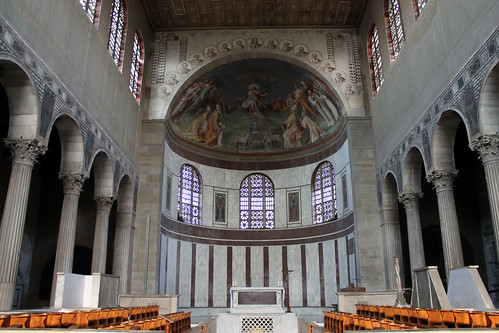Ash Wednesday: Santa Sabina
February 23, 2012

In the long history of the Church of Rome, in certain liturgical seasons we find the tradition of station days. These days were originally days of fasting and penance, to which were accompanied liturgical processions. The churches in Rome associated with these processions on particular days became known as stational churches. The best known stational churches are the ones associated with the season of Lent. Thus the Catholic faithful in Rome during Lent found an opportunity to attend pious processions throughout the penitential season. The tradition of the stational church continues on in Rome, especially on the feast of Ash Wednesday. On that day, the Holy Father arrives at the Benedictine Monastery of St. Anselm (San Anselmo) to begin the liturgy. Gathered with him in the small monastery church are the Dominicans and Benedictines in choir, along with various cardinals, bishops, clerics, and lay people. Then begins a procession from San Anselmo to the Dominican church of St. Sabina (Santa Sabina), just up the Aventine hill. In procession, the gathered faithful sing together the litany of the saints. Upon arriving at Santa Sabina, the Holy Father begins the Mass of Ash Wednesday. The Pope distributes ashes personally to the gathered cardinals and bishops. In the Italian style, ashes are usually sprinkled on the crown of the head, rather than marked on the forehead. During the Mass, the Dominican friars and Benedictine monks assist the Holy Father in the liturgy, serving as deacons and altar servers. A few of the priests of St. Joseph Province had the opportunity to assist this year in the distribution of ashes to the people in Santa Sabina, as well as the many attending outside the very full church. The same friars also distributed Holy Communion to the Cardinals and lay people alike in the Basilica of Santa Sabina. The Basilica was built from the home of the holy woman martyr Sabina in the 5th century by a Roman priest, Peter of Illyria. The park next to the basilica continues to bear his name. A wooden door dating to the fifth century, which is still in use, contains the oldest known depiction in art of Christ crucified. The relics of St. Sabina can be found under the high altar of the Church. In the early 13th century, Pope Honorius III gave the Church to the new and rapidly growing Dominican Order. The adjacent convent has served as home to St. Dominic, Pope St. Pius V, St. Hyacinth of Poland, and St. Thomas Aquinas. It remains the headquarters of the Dominican Order and the home of the Master of the Order of Preachers. Below is a slideshow with some very few photos of the Ash Wednesday liturgy both at San Anselmo and Santa Sabina, interspersed with some pictures of the Basilica of Santa Sabina taken the day before.



